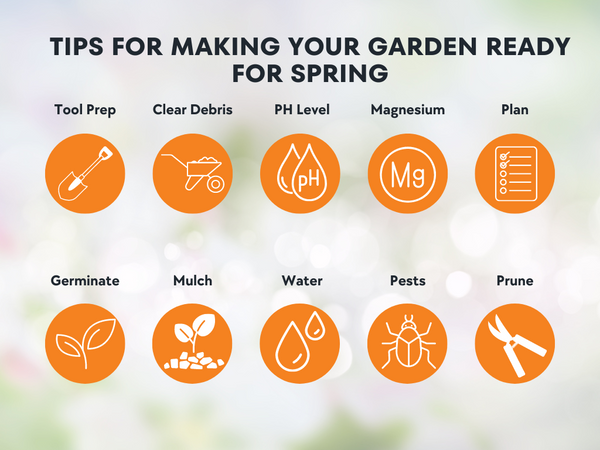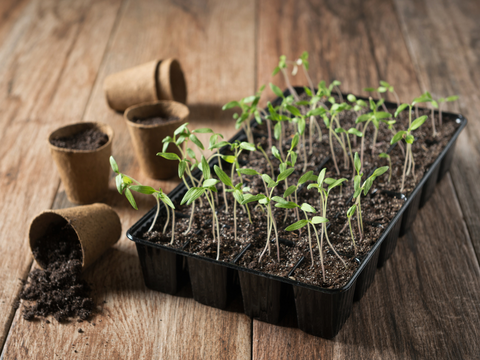Tips For Making Your Garden Ready for Spring
April 04, 2023Spring is just around the corner. It is a season of renewal and growth, and what better way to commemorate it than by preparing your garden for the upcoming months?

Whether you are a passionate gardener or just starting, preparing your garden for spring can be a rewarding and enjoyable experience. From clearing out debris to testing soil pH and planning your planting, there are a few key steps to ensure your garden thrives in the coming months.
In this article, we'll provide some helpful tips and tricks for preparing your garden for spring so you can enjoy a beautiful and bountiful garden all season long.
1. Start With Cleaning Your Garden Tools
Cleaning your garden tools is important in preparing your garden for spring. Over the winter months, tools can become rusty or clogged with dirt, making them less effective when it comes time to start working in the garden again. Here are some tips for cleaning your garden tools:
- Remove dirt or debris from the tools using a brush or a damp cloth.
- Soak metal tools in equal parts water and white vinegar for a few hours to help dissolve rust.
- For wooden handles, sand away any rough spots or splinters with sandpaper.
- If your tools are particularly dirty, use warm water and dish soap to help remove any caked-on dirt or grime.
- After cleaning, dry the tools thoroughly to prevent rust and corrosion.
- Apply a light coat of oil or wax to metal parts to help prevent rust and keep the tools in good condition.
By cleaning and maintaining your garden tools, you'll be able to work more effectively and efficiently in your garden, and your tools will last longer too. Plus, you'll be ready to tackle any gardening tasks that come your way as soon as the weather starts to warm up.
2. Clear Out Debris
Before planting, clear out any debris or dead plants from the previous season. Winter weather can cause a buildup of fallen leaves, dead plants, and other debris, which can harbor pests and disease and prevent new growth from thriving1. Here are some tips for clearing out debris from your garden:
- Start by raking up fallen leaves or other debris, including dead flowers, stems, and branches. If you have a compost pile, add the debris into it to create nutrient-rich compost for your garden.
- Eliminate any weeds that may have sprouted during the winter months. Be sure to pull out the entire root system to prevent regrowth.
- Cut back dead or damaged branches from trees and shrubs to promote healthy growth.
- Dispose of any diseased plant material separately from the rest of the debris to prevent the spread of disease.
Clearing out debris will create a clean slate for your garden to start fresh in the spring. This will help prevent pests and diseases and allow new growth to thrive. Plus, it's a great way to get some exercise and fresh air after a long winter!
3. Prepare The Soil and Test The pH Level of The Soil
Once your garden is cleared, you can prepare the soil for planting. Good soil is the foundation for healthy plants, providing them with the nutrients, water, and oxygen they need to grow and thrive2.
To prepare your soil, loosen the soil by tilling or digging to a depth of at least eight inches3. This will help to freshen the soil and create space for roots to grow. Add organic material to the soil, such as compost, aged manure, or shredded leaves. This will help improve soil structure, drainage, and fertility4.
It's important to test the pH level of your soil to determine if it's too acidic or alkaline. You can do this with a simple soil test kit from a garden center or online. Most plants prefer a pH level between 6.0 and 7.05. Adjust the pH level by adding lime to raise the pH or sulfur to lower it6.
By preparing your garden's soil, you'll create a healthy environment for your plants to thrive. Nutrient-rich soil with the right pH level will promote strong root growth and healthy plant development, leading to more productive yields and vibrant blooms.
4. Add Harmony's Magnesium Flakes to The Soil to Improve the Overall Health of Your Plants
Magnesium is an important nutrient for plant growth7. Adding Harmony's Magnesium Flakes to the soil can provide several benefits for plant growth and soil health. Here are some of the benefits:
Improves soil structure: Magnesium helps to improve soil structure and texture8, making it more porous and easier for roots to grow. This can lead to better water and nutrient retention in the soil.
Promotes healthy plant growth: Magnesium is a key component in chlorophyll production, which is essential for photosynthesis and plant growth9. Adding magnesium to the soil can help promote healthy plant growth and improve overall plant health.
Increases nutrient uptake: Magnesium helps plants to take up other nutrients, such as nitrogen, phosphorus, and potassium, more efficiently. This can lead to better nutrient uptake and healthier plants.
Enhances flower and fruit production: Magnesium can also help to improve flower and fruit production in plants10. By adding magnesium to the soil, you may see an increase in the number and quality of flowers and fruits.
To apply the magnesium flakes, dissolve the flakes in water and apply the solution to the soil around the plant. Adding Magnesium Flakes to the soil can help improve plants' overall health and productivity. However, it's important to test the soil and follow the instructions carefully to avoid over-fertilization and other problems.
5. Plan Your Planting
By planning out your garden beds and choosing the right plants, you'll be able to maximize your space and create a beautiful and productive garden. Here are some tips for planning your planting:
- Consider your climate and growing zone when selecting plants11. Choose plants that are well-suited to your area and will thrive in the conditions you can provide.
- Determine the amount of sunlight and shade each area of your garden receives throughout the day. Some plants require full sun, while others prefer partial or full shade.
- Plan your garden beds based on your chosen plants' size and spacing requirements. Be sure to leave enough space between plants to grow to their full size.
- Consider companion planting, which involves planting certain plants together to benefit each other12. For example, planting marigolds near tomatoes can help deter pests.
By planning your planting carefully, you'll be able to create a beautiful and productive garden. You'll also be able to avoid overcrowding, leading to disease and pest problems.
6. Start Seeds Indoors

A strong and healthy crop can be ensured by starting seeds indoors, which is a great method to get a head start on your garden13. By starting seeds indoors, you can give your plants a warm and protected environment to grow in and extend your growing season.
Firstly, choose a sunny location for your seedlings, such as a south-facing window or under-grow lights. Make sure the area is warm and draft-free. Then use seed trays or small pots filled with a good-quality seed-starting mix. This will give your seeds the necessary nutrients and moisture to germinate and grow.
Secondly, follow the instructions on the seed packets for planting depth and spacing, and water your seedlings carefully, ensuring the soil is evenly moist but not waterlogged. Use a spray bottle or a gentle stream of water to avoid disturbing the seeds.
As your seedlings grow, gradually adjust them to outdoor conditions by increasing their exposure to sunlight and temperature changes. It will help them develop strong stems and leaves.
7. Add Mulch Around Your Plants
Once your plants are in the ground, add a layer of mulch around them. It is a great way to improve their health and help them grow better14. Mulch is a material layer placed on top of the soil around plants. Here are some benefits of adding mulch:
Retains Moisture: Mulch aids in retaining moisture in the soil by reducing evaporation15. This means you'll have to water your plants less frequently.
Controls Weeds: A layer of mulch can help to suppress the growth of weeds16, which compete with your plants for nutrients and water.
Regulates Soil Temperature: Mulch acts as a natural insulator, helping to regulate the soil temperature around your plants17. This can be particularly useful in extreme weather conditions.
Improves Soil Health: As mulch breaks down, it adds organic matter to the soil, which can improve its structure, nutrient content, and ability to hold water18.
When adding mulch around your plants, keep the mulch about 2-3 inches away from the base to prevent rot and disease. Additionally, use organic mulch materials such as leaves, wood chips, straws, or grass clippings to provide the maximum benefits to your plants19.
8. Water Your Plants Regularly
Keep your plants hydrated by watering them regularly. It is essential to their health and growth20. To avoid damaging the plants, use a watering can or hose that sprays gently.
Water your plants in the morning when temperatures are cooler, and the sun is less intense. This will give the plants enough time to absorb the water before the day's heat causes it to evaporate. Also, water your plants deeply so the water reaches the roots. Watering deeply helps the roots grow deeper, making the plants stronger and more resilient. At the same time, avoid overwatering. Overwatering can be just as damaging to plants as underwatering. Water your plants only when the top edge of the soil feels dry.
Remember, healthy plants require a balance of water, sunlight, and nutrients. By providing your plants with regular and appropriate watering, you'll be helping them thrive and grow to their fullest potential.
9. Monitor For Pests and Diseases
Look for any pests or diseases that may attack your plants. You can use organic methods to control them, such as companion planting, handpicking, or natural pest repellents.
Use Harmony's Essential Oils to Prevent Your Plants from Pests And Diseases
Harmony's Essential Oils can be a useful addition to your gardening routine, providing various plant benefits. Following are some of the most effective and common essential oils in gardening:
Peppermint oil: Peppermint oil repels pests such as ants, aphids, and flea beetles. Dilute a few drops of peppermint oil in water and spray it on your plants to keep pests at bay.
Eucalyptus oil: Eucalyptus oil has antifungal properties that can help prevent plant diseases21. Mix a few drops of eucalyptus oil into a spray bottle of water and use it to mist your plants to keep them healthy.
Lavender oil: The calming aroma of Lavender oil is well known, but it's also an effective insect repellent. Dilute a few drops of lavender oil in water and spray it on your plants to repel mosquitoes, flies, and other pests.
Lemon oil: Lemon oil is a natural insecticide that can help protect your plants from pests. Mix a few drops of lemon oil with water and spray them on your plants to repel ants, aphids, and insects.
Tea tree oil: Tea tree oil holds antibacterial and antifungal properties that can help prevent plant diseases22. Combine water and a few drops of tea tree oil in a spray bottle and use it to mist your plants to keep them healthy.
When using essential oils in gardening, it's important to dilute them properly and use them in moderation to avoid damaging your plants. Always test a small area first to ensure the oil doesn't harm your plants. Additionally, make sure to use high-quality, pure Essential Oils by H.E.A.L.'s, as synthetic oils may not provide the same benefits.
10. Prune
Pruning is an important technique in gardening that involves cutting back plants to remove dead or diseased parts, control their size and shape, and encourage new growth23.
To prune, look for dead, diseased, or damaged branches, water sprouts, suckers, and branches that are crossing or rubbing together. Cut them with sharp and clean pruning tools, such as bypass pruners, loppers, and pruning saws. Dull or dirty tools can damage the plant and spread disease.
Pruning will also improve the appearance of your garden.
11. Enjoy
Finally, sit back and enjoy your beautiful garden. Take time to relax and appreciate the fruits of your labor.
The Bottom Line
Getting your garden ready for spring is a critical step in preparing for a successful growing season. It involves cleaning up debris, preparing the soil, pruning, planning your planting, starting seeds indoors, and applying fertilizer and nutrients as needed. By taking these steps, you can promote healthy plant growth, prevent nutrient deficiencies, and enhance flower and fruit production. Additionally, it's important to continue caring for your plants throughout the season with regular watering, fertilization, and pest control as needed. You can enjoy a bountiful harvest and a beautiful garden all season long with good care and attention.

